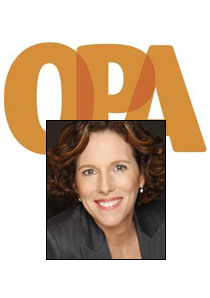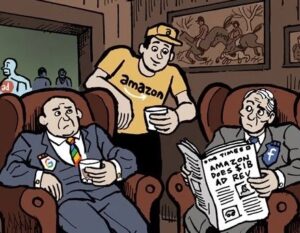 This week, the Online Publishers Association (OPA) , a not-for-profit trade organization that represents large, online publishers, will gather leaders together from the online publishing community for its annual summit in Coral Gables, Florida.
This week, the Online Publishers Association (OPA) , a not-for-profit trade organization that represents large, online publishers, will gather leaders together from the online publishing community for its annual summit in Coral Gables, Florida.
Pam Horan is President of the OPA and she discussed the OPA’s upcoming event with AdExchanger.com as well as her association’s initiatives (such as its “OPA ad units“) and the state of the web publishing today.
AdExchanger.com: Looking into your crystal ball, what do you think might be some of publishers’ takeaways from the upcoming OPA Summit?
PH: If we think about what’s hot, I would say mobile. It’s everything from thinking about how online publishers are delivering their content in compelling ways to understanding how advertising can be effective on thes platforms. Video has similar challenges with content and advertising – and then there’s social. If we consider that the majority of top links that are shared are based on content from, and links to, OPA sites, OPA publishers put the media in social media. Without our members’ content, there is no social.
Also, another takeaway may be the insights and opportunity that publishers are gaining from social. For example, we have Nate Richardson, who is the President of Gilt City, who will talk about social, local commerce. That is certainly something that is on the horizon potentially for some of the publishers: the intersection between commerce, content and social.
It seems like Facebook is social to a large degree. What is your sense of what online publishers are thinking regarding a monetization strategy via Facebook?
Let me start by saying that we did some research with Harris Interactive last year that looked at the connections that consumers have with different content online. What we wanted to do was understand the connections that consumers have, because if you think about when you wake up in the morning, the first place you may go – maybe you’ll go to the New York Times because you want to find out what’s happening today in the news. From there, you may decide you’re going to go to Yahoo Finance because you want to check out your stock portfolio. And from there, you’re going to go to Facebook because you want to see what your friends are doing today. In that one web surfing session, you’ve just gone to three distinct environments: media sites, portal – in the case of Yahoo Finance – and then Facebook. And you’re right, there’s only one player really there. Obviously we’re seeing an emergence of other types of tools that support that environment and are great for social like Twitter, Tumblr and so on. But they really own the landscape right now.
We found that as an individual you have different types of connections with content across the different environments. And the connections that consumers have with content on the publisher sites is much more significant than it is on Facebook as well as the portals. What we saw was – based on measuring the trust of the content – the emotional connection the people had with the content. Ultimately, we found that there was a brand halo that existed for advertisers whose ads appeared in the different environments. There was a more substantial one for those that were appearing on online publisher sites. We’re very excited about the opportunity for marketers to leverage that as a platform. Certainly, we’ve seen a great deal of interest from the marketing community about what the opportunity of Facebook is. But I think it’s still yet to be proven what the real ROI is.
There’s a lot of testing that marketers are doing today. But ultimately, they’re going to need to see the results. There’s a bit of this shiny‑new‑object syndrome and there’s some real proven results that marketers experience in this contextual environment that publishers can offer.
Have OPA ad units been successful?
We estimate that over 600 campaigns employing the OPA Ad Units have run on member sites since we launched them in July of 2009. In November 2010, we released a biometric and eye tracking research study to evaluate the impact of the OPA Ad Units to demonstrate their effectiveness in creating emotional engagement and visual attention. The results were significant with 96% of the participants paying attention to the OPA Ad Units during a natural surfing experience, 67% of the participants not only noticing the OPA Ad Units during the first 10 seconds, but going back to look at the ad after the first 10 seconds (when the interactive would have completed) and, maybe most importantly, during the first 10 seconds, we found that the OPA Ad Units emotionally resonated with the surfers at the same level as all the other elements on the page, including the content.
What’s next for the ad units?
OPA members continue to find that the existing three units – OPA Pushdown, OPA Fixed Panel and OPA XXL – are providing their marketing and agency partners with very impactful and effective ways to deliver their brand messages. Many marketers including NASDAQ and Mercedes continue to use these units for new product launches and therefore they are seeing the results that support the premium the publishers can command for the OPA Ad Units. At this point, we don’t have plans to introduce new ad units.
Let’s move to the agencies and publishers. Are there any themes right now where publisher pain points around what they can do better or try to understand with their agency relationships? Do you feel any bullets there?
Absolutely. There are a couple of key things. Number one, and we’ve seen this trend for the last several years, agencies are looking for fewer partners. There is such a plethora of options. Number one, they’re looking for fewer partners. They’re looking for smart partners that can offer cross‑platform, surround‑the‑consumer solutions on whatever media platform the consumer is connecting with their brand. That’s one of the things that really distinguishes the online publishers because Facebook doesn’t have a cross‑platform solution, nor does Search. That is one of the things that agencies are really looking to online publishers to be able to deliver on: smart, integrated programs across platform.
A nice corollary there, and I’m wondering, is the agency trading desk world another connection? Do you have any opinions there about how publishers are trying to approach it because it could be, in some ways, cannibalizing their direct sales?
It’s early innings. We have some publishers who have created private exchanges to be able to serve the agency community. CBS, NBC, Conde’ Nast, Gannett just announced a private label solution. Similar to what transpired ultimately with the ad networks, or because of some of the activities that happened with ad networks, there is certainly a desire on behalf of the publishers to have a clear understanding of how their inventory is being represented. We have seen many of the publishers decide that they wanted, and to only represent their inventory because they could best represent their brand. By doing so, they had a better opportunity to monetize their inventory. We’re going to see a variety of things publishers will test. Ultimately, we want to make sure that there is a way for them to represent their inventory and make sure that they’re managing it in a way that obviously doesn’t cannibalize but is also a value to helping marketers reach their consumers.
How are publishers approaching a solution for themselves as they continually need to “hook” into tech? Publishing has not been technology-centric, of course.
For starters, we have a technology committee at the OPA where we convene all the CTOs and CIOs. It’s a forum where we’re doing a lot of information exchange. We’re also creating research for the members. For example, we did a survey around data protection management and potential monetization.
If I look across the membership, I would say that the majority have people in place that are dedicated to not only the general technology, which historically have been CMS systems, but also the infrastructure to understand what is happening on their site and what they need to do to potentially be smarter about the audience insights that they’re gathering; then, how to share that with the agency community.
I’ve seen a movement in the last several years for the staffing up and the acquisition of technology. Ultimately, it is about getting better insights in order to be able to drive not only their businesses to be smarter about being able to deliver those solutions to agencies and marketers, but also about how they do it.
Follow Pam Horan (@OPA_PamHoran) and AdExchanger.com (@adexchanger) on Twitter.
By John Ebbert











